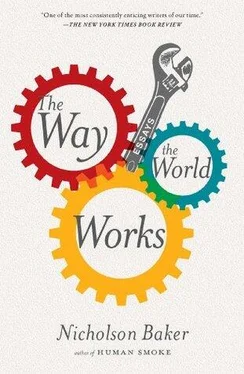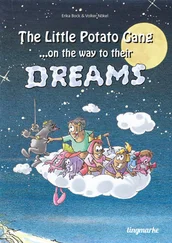Nicholson Baker - The Way the World Works
Здесь есть возможность читать онлайн «Nicholson Baker - The Way the World Works» весь текст электронной книги совершенно бесплатно (целиком полную версию без сокращений). В некоторых случаях можно слушать аудио, скачать через торрент в формате fb2 и присутствует краткое содержание. Год выпуска: 2012, Издательство: Simon & Schuster, Жанр: Публицистика, Критика, на английском языке. Описание произведения, (предисловие) а так же отзывы посетителей доступны на портале библиотеки ЛибКат.
- Название:The Way the World Works
- Автор:
- Издательство:Simon & Schuster
- Жанр:
- Год:2012
- ISBN:нет данных
- Рейтинг книги:4 / 5. Голосов: 1
-
Избранное:Добавить в избранное
- Отзывы:
-
Ваша оценка:
- 80
- 1
- 2
- 3
- 4
- 5
The Way the World Works: краткое содержание, описание и аннотация
Предлагаем к чтению аннотацию, описание, краткое содержание или предисловие (зависит от того, что написал сам автор книги «The Way the World Works»). Если вы не нашли необходимую информацию о книге — напишите в комментариях, мы постараемся отыскать её.
), here assembles his best short pieces from the last fifteen years.
The Way the World Works
OED
Modern Warfare 2
Through all these pieces, many written for
, and
, Baker shines the light of an inexpugnable curiosity.
is a keen-minded, generous-spirited compendium by a modern American master.
The Way the World Works — читать онлайн бесплатно полную книгу (весь текст) целиком
Ниже представлен текст книги, разбитый по страницам. Система сохранения места последней прочитанной страницы, позволяет с удобством читать онлайн бесплатно книгу «The Way the World Works», без необходимости каждый раз заново искать на чём Вы остановились. Поставьте закладку, и сможете в любой момент перейти на страницу, на которой закончили чтение.
Интервал:
Закладка:
Weeding is a term of art in librarianship, and it is a necessary part of what librarians do. If you have five copies of an old edition of Samuelson’s Economics, or of Booth Tarkington’s The Gentleman from Indiana, your librarianly obligation may be to reduce the number, so that there will be space for other books. The library sells them or gives them away — or even throws them away, if nobody wants them — so as not to be choked by the foliage of what was once heavily in demand but is no longer. But beyond such obvious examples, weeding a rich old collection such as San Francisco’s takes time and careful thought. If your potential weed is a little out of your main area of knowledge, you have to look it up in standard bibliographies. You must be mindful of the traditional strengths and weaknesses of your library, and the myriad secondary ways in which an out-of-date book may enlighten the historically curious. If the book under your eye is an old edition of something that has been republished, you have to ask yourself whether that old edition has some intrinsic merit — something about its annotation, or the eminence of its editor — that the new one may lack. And even then there are differences of opinion, of course. To quote from a book called Garden Friends and Foes, by Richard Headstrom, “If you were asked to prepare a list of weeds and compare it with one prepared by someone else, they would probably not be in complete agreement.”
Kenneth Dowlin himself offered a defensible theory of discarding to a questioner at a meeting in 1992. He said, “We have many books where we may buy two hundred copies of that book because there are thousands of people who want to read it. It makes no sense to keep all two hundred copies for the rest of our life. So at the time that the usage of that particular book drops, we will retain one, two, five, whatever the appropriate number is.” Except for the inflated figure of two hundred, that is a fair description of what went on before Dowlin took command, when the volume of junked books was relatively small. But what has gone on at the San Francisco Public Library over the last year was not weeding in this specialized sense. I found Garden Friends and Foes this spring, in a room near the shipping-and-receiving entrance in the Old Main Library — a windowless, high-ceilinged room, measuring maybe ten by twelve feet. It’s called the Discard Room. On most Tuesdays, until this past January, a Department of Public Works truck — a five-ton flatbed truck with wooden sides of the kind used to pick up brush and old washing machines — drove down to the Discard Room and two, sometimes three men threw the books, which were often tied with string in bundles of eight or ten, into the back. Sometimes the truck held other things, too, like an old chair or a shopping cart left on library property by a street person or hundreds of out-of-print phonograph records, and sometimes it just held books. When it was loaded (and it could hold perhaps 2,500 bundled volumes), the truck drove to a transfer station, where the books were shifted to big rigs, along with the rest of the day’s garbage, and then taken to a landfill. In fairness to the current administration, book dumping, on a much smaller scale, has gone on for decades. (The administration sometimes says that a surplus-property law forced them to throw away all discards until 1989, but it is also correct to say that it was not until 1989 that the library sought official permission from the city to sell some of its surplus books through the Friends of the Library bookstore.) Things got especially bad this past winter, however, when Kathy Page put out the call to all stations: Weed . Sometimes the crew arriving from the DPW would crack open the door of the Discard Room and close it fast, afraid that an eight-foot-high pile of books would collapse on them.
Here is what two librarians who had been part of a weeding team told me one Sunday at a coffee shop:
LIBRARIAN A: They said, “Get rid of as much as possible.” And they said, “Anything that doesn’t look like we should have it in the New Main Library, if it doesn’t look good, if it needs to be repaired. .” And then there was the question whether when you sent things to be repaired, was it actually being repaired, or were they tossing it?
LIBRARIAN B: There seemed to be a reluctance to send things to Repair because they [in Repair] were “overwhelmed.”
LIBRARIAN A: People were beginning to think, “Wait a second, these are just being tossed.”
LIBRARIAN B: Actually, we don’t know what happened, because the librarians weeded their areas but a senior librarian had the final word. We don’t know what she did.
LIBRARIAN A: She started putting everything on the same truck, and I said, “This is not to be thrown away, it’s not to be discarded.” She said, “No, just put it on.”
There are now no copies of Garden Friends and Foes on the shelves of the San Francisco Public Library. There are no duplicates of it at the University of California at Berkeley, or at Davis, Stanford, or UCLA. There are copies of a number of Headstrom’s other books in SFPL’s collection — he has written about spiders, lizards, birds, insects, and even a Complete Field Guide to Nests in the United States —but this sole copy of his work on weeds was weeded. Why? Its binding was slightly torn, and the weeders, as they are called, have at times been urged to weed quickly and in quantity, basing their decisions in large part on looks.
I hasten to say that many of the books in the Discard Room which I have personally checked do have duplicates on the shelves, or at least are represented by later editions of the same work. The 1983 Arco Civil Service Exam Book for Sanitation Workers, of which the library has twenty copies — I found it in the Discard Room two months ago under ten books about ethics and a mint Clarendon Press edition of Leibniz’s Logical Papers —makes sense to discard. (Question 67 on page 90 of Sanitation Workers asks you to choose the last phrase of the following jumbled sentence: “the book / the top shelf / of the bookcase / wanted was on / which she.” The answer is “of the bookcase”: “The book which she wanted was on the top shelf of the bookcase.” Not in the back of a DPW truck.) But here are some of the other books I left with, after one unannounced visit, which either have no record online at all, or say “Ask librarian for holdings information,” a phrase that is often, especially in the case of older circulating books, code for “I am a last copy, and I have been purged.” There is Crumbling Idols, by Hamlin Garland; a lovely little Knickerbocker Press book with color plates called The Way to Study Birds, from 1917; a 1907 edition of Rivers of North America, by Israel Russell, with a complete chemical analysis of a water sample taken from a hydrant in Los Angeles on September 8, 1878, along with similar results for other samples from the Hudson, the Cumberland Reservoir, the Mohawk River, and the Rio Grande; and Handbook for the Woman Driver, by Charlotte Montgomery, which devotes a whole chapter to “Clothes and Beauty En Route.” (“Dark glasses are a must .”) Studies of Abnormal Behavior in the Rat, by Norman Maier, was another last copy. (On page 19: “An electrified grill was interposed between the jumping platform and the canvas net. Now the rat was punished not only for staying on the platform, but also for jumping from the platform. As a control the same grill was used in the case of the female rat. This technique failed to produce neurotic attacks in either animal.” Give it time.)
Although the weeding continues, the good news is that since this past January no more books have been dumped. On January 29, the San Francisco Chronicle ’s Andrew Ross and Phillip Matier published a front-page story headlined SF LIBRARY TOSSING THOUSANDS OF BOOKS and a picture of the Discard Room. “The ongoing crime was so apparent by then,” one staff member told me. “The blood was seeping under the door.” Since then, no book, to my knowledge, has been thrown away. (True, many thousands of recent unbound periodicals to which the library subscribes — serials with titles like Welding Design & Fabrication, Nutrition Reviews, Journal of Tribology, The Canadian Journal of Soil Science, Car and Driver, and Bee Culture —were secretly tossed into recycling bins this past February, March, and April; but no books were.) Instead, nonprofit and community groups are invited to tour a large room in the basement of the Old Main; the last public giveaway got rid of five thousand books. They have gone to other libraries, here and abroad, and to schools, prisons, and villages in Madagascar and Armenia. Every Friday this month the general public will have a chance to take whatever the charities don’t want. Deetje Boler, of the Gray Panthers, left this summer with about twenty boxes of books: works on labor history and birds; books by McPhee, Malamud, Herb Caen, and a first-edition Elizabeth Bishop. (They are holding them in trust, waiting for the library to come to its senses.) At least we can be thankful that the newer rejects will continue their lives somewhere, and not make up a semi-sentient layer in the ultimate closed stack — the sanitary landfill.
Читать дальшеИнтервал:
Закладка:
Похожие книги на «The Way the World Works»
Представляем Вашему вниманию похожие книги на «The Way the World Works» списком для выбора. Мы отобрали схожую по названию и смыслу литературу в надежде предоставить читателям больше вариантов отыскать новые, интересные, ещё непрочитанные произведения.
Обсуждение, отзывы о книге «The Way the World Works» и просто собственные мнения читателей. Оставьте ваши комментарии, напишите, что Вы думаете о произведении, его смысле или главных героях. Укажите что конкретно понравилось, а что нет, и почему Вы так считаете.












